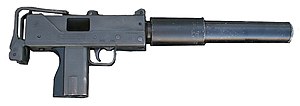| Military Armament Corporation M10 | |
|---|---|
 MAC-10 (.45 ACP) with suppressor and without magazine. | |
| Type | Machine pistol Submachine gun |
| Place of origin | United States |
| Service history | |
| In service | 1970–present |
| Used by | See Users |
| Wars | |
| Production history | |
| Designer | Gordon Ingram |
| Designed | 1964 |
| Manufacturer | Military Armament Corporation |
| Unit cost | $120 |
| Produced | 1970–1973[2] |
| Specifications | |
| Mass | 2.84 kg (6.3 lb) empty without a suppressor |
| Length |
|
| Barrel length | 146 mm (5.7 in) |
| Width |
|
| Cartridge |
|
| Action | Straight blowback[3] |
| Rate of fire |
|
| Muzzle velocity |
|
| Effective firing range |
|
| Maximum firing range | 100 meters (for .45 ACP) |
| Feed system |
|
| Sights | Iron sights |
The Military Armament Corporation Model 10, officially abbreviated as "M10" or "M-10",[5] and more commonly known as the MAC-10, is a compact, blowback operated machine pistol/submachine gun that was developed by Gordon Ingram in 1964. It is chambered in either .45 ACP or 9mm. A two-stage suppressor by Sionics was designed for the MAC-10, which not only abates the noise created but makes it easier to control on full automatic (although it also makes the gun far less compact and concealable).[6]
Military Armament Corporation never used the "MAC-10" nomenclature in its catalogues or sales literature, but "MAC-10" is frequently used by Title II dealers, gun writers, and collectors.[citation needed] For a decade, the semi-automatic pistol version of the weapon was forbidden in the U.S. under the assault weapons ban enacted by Congress in 1994.
- ^ Lee E. Russel (1985). Grenada 1983. p. 41.
- ^ Miletich, John (2003). Homicide Investigation: An Introduction. Scarecrow Press. p. 134.
- ^ McNab, Chris (2009). Firearms. Bath, UK: Parragon. p. 229. ISBN 978-1-4075-1607-3.
- ^ "MAC Ingram M10 / M11 (USA)". Weapon.ge – Modern Firearms Encyclopedia. Archived from the original on 7 August 2016. Retrieved 11 June 2011.
- ^ a b c "Operation and Maintenance Manual: Military Armament Corporation" (PDF). Military Armament Corporation.
- ^ Dartford, Mark, ed. (1985). Modern Warfare. London: Marshall Cavendish Books. ISBN 0-86307-325-5.